4/10/2015
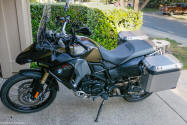 I would like to document my installation and results of the Innovv C3 action camera on
a 2015 BMW F800GS Adventure motorcycle. My motivation and choice of this camera is based on a desire for having the equivalent of a "dashcam" for the motorcycle that will continuously document my ride without having to even think about it. I figure this will help address any disputes or ambiguities in the unfortunate situation of an accident, dispute with the police or help keep everybody honest, to document what happened in case of a hit-and-run and somebody later finds my dead body and bike on the side of the road, or lastly to document some of my adventure rides.
I would like to document my installation and results of the Innovv C3 action camera on
a 2015 BMW F800GS Adventure motorcycle. My motivation and choice of this camera is based on a desire for having the equivalent of a "dashcam" for the motorcycle that will continuously document my ride without having to even think about it. I figure this will help address any disputes or ambiguities in the unfortunate situation of an accident, dispute with the police or help keep everybody honest, to document what happened in case of a hit-and-run and somebody later finds my dead body and bike on the side of the road, or lastly to document some of my adventure rides.
The Innovv C3 camera seems especially geared for this purpose. It has a detachable, yet small waterproof video head on the end of a 4' cable that plugs into a separate recorder. The recorder can be configured to run continuously, overwriting the oldest footage in a looping manner, and to automatically start when you turn on the bike, and stop when the bike power is shut off. The recorder is quite small at about 2.5" x 1.5" x 1", but is not waterproof. It accepts a microSD card for storage just like a GoPro. Also previously having a GoPro 3+ silver edition mounted on the handlebars of my DRZ400S dual sport, it sheared off its mount from my handlebars on a particularly rough ride through Death Valley, losing $300 somewhere on the trail in the process.
You can read and see more pictures about this trip
here.
Researching a replacement that could also serve as a dashcam, I realized the GoPro is not particularly well suited due to a lack of an autostart and bulkier more obtrusive setup; and that other more capable and affordable options exist. I decided on the Innovv C3 based on its feature set, baseline video quality of 1080P at 30fps, past reports by others, and a much more affordable price of $130 for everything including the supporting cables and various mounts. With a 32GB microSD card, it should be capable of capturing a buffer of the last 5 hours.
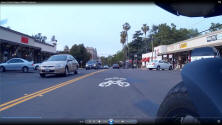 The Innovv C3 also supports interchangeable lenses and comes stock with either a 90 degree or 120 degree angle lens, with the alternate
lens being orderable for an extra $30. I decided on the 90 degree angle given the camera will be on a fixed mount and not suffer from the ambiguity of one mounted on your helmet and being subjected to the movement of your head.
The narrower focal length of the 90 degree angle will also have less distortion and help more easily discern details in front of you,
with some trade-off of losing more information to your sides. Some captured video of rides with my setup are shown
by a link at the bottom to give you an idea of this field of view. In
additon a screen shot of the video is shown here to the right while the
motorcycle was rolling down the street at a slow speed.
The Innovv C3 also supports interchangeable lenses and comes stock with either a 90 degree or 120 degree angle lens, with the alternate
lens being orderable for an extra $30. I decided on the 90 degree angle given the camera will be on a fixed mount and not suffer from the ambiguity of one mounted on your helmet and being subjected to the movement of your head.
The narrower focal length of the 90 degree angle will also have less distortion and help more easily discern details in front of you,
with some trade-off of losing more information to your sides. Some captured video of rides with my setup are shown
by a link at the bottom to give you an idea of this field of view. In
additon a screen shot of the video is shown here to the right while the
motorcycle was rolling down the street at a slow speed.
The other option to decide on for the right camera configuration to
order is whether to get the capacitor or battery based model. Contacting Innovv through email, they indicated that the capacitor based configuration is better for a vehicle where the camera will be externally powered, as the capacitor will not wear out over time.
Even a lithium battery has a finite number of charge/discharge cycles
before it evenutally wears out. In the vehicle usage model, I would
prefer to not have to worry about this wearing out after a few
hundred rides since the camera will always be running. The downside of the capacitor configuration is that it can't be used as a standalone recorder. The battery option is more suited for portable usage where no separate power supply is convenient. Given this and my planned usage, I ordered the capacitor based
configuration.
After examining my bike for the most effective installation, I decided to mount the camera head on the bottom of one of my driving lights, down where it will not be as noticeable, but still have reasonably good visibility of the road ahead, but being off to the side so as to not pick up too much debris thrown up by the front wheel. I also expect that this more obscure location will not be noticeable by others that may otherwise tamper or interfere with its operation.
I placed the recorder further back under the seat of the bike where I can more easily access it without tools for the purpose of dumping camera footage, swapping microSD cards, or reconfiguring it, yet more protected from the weather. After examining the F800GS, I realized that it is still possible for some road spray to get under the seat through the rear shock. For this reason, I found a small plastic electronic project box just big enough to hold the recorder, cut a few snug holes in the side for sliding in the cable for the video head and micro-USB-like connector for power and USB connectivity. As a result, it will still not be sufficiently waterproof from immersion, but should be sufficient to keep out road spray and other debris. Given the limited space under the stock seat this bike, the case can't be no larger than 4.5" x 2.5" x 1.25". I attached the bottom of the box to the top of the metal electronics module of the bike with double-sided foam tape that can be removed in case of service. I snaked the cable from the camera head from the left driving light up above the radiator, under the top simulated tank cover, and back under the saddle area to the recorder, using a few zip ties for securing it along the way. The cable length was just long enough to reach between these two points, but no more.
The Innovv C3 recorder requires USB power through a supplied adapter cable. To provide this power I used a 12V to USB adapter ordered off Amazon (Drok 3A/15W dual power adapter). I connected this up to
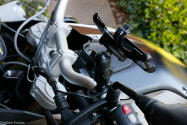 my bike power through a Touratech TPS15 relay switched power module that I installed separately under the simulated tank cover. This has allowed me to connect accessories like this recorder and a GPS to my bike, and have them automatically switched on when the key is turned on, and switch off with a 1 minute delay after the key is turned off. I tapped the power module control wire onto the switched CAN bus wire that is routed to the existing accessory connector reserved for those willing to pay for the mucho grande official BMW GPS. Personally, I use a standard automotive Garmin Nuvi on a RAM mount, and find it to work just as good, and costing only about $100. If it rains, just throw a clear plastic sandwich bag over it cinched with a rubber band. Unlike an iPhone, the resistive touch interface of the Nuvi will still work with gloves or with a bag over the display.
my bike power through a Touratech TPS15 relay switched power module that I installed separately under the simulated tank cover. This has allowed me to connect accessories like this recorder and a GPS to my bike, and have them automatically switched on when the key is turned on, and switch off with a 1 minute delay after the key is turned off. I tapped the power module control wire onto the switched CAN bus wire that is routed to the existing accessory connector reserved for those willing to pay for the mucho grande official BMW GPS. Personally, I use a standard automotive Garmin Nuvi on a RAM mount, and find it to work just as good, and costing only about $100. If it rains, just throw a clear plastic sandwich bag over it cinched with a rubber band. Unlike an iPhone, the resistive touch interface of the Nuvi will still work with gloves or with a bag over the display.
After installing the setup, it needs to be configured and updating of the firmware. To do this, the best approach is to connect to the recorder (with the lens head still attached) via the supplied USB adaptor cable to a notebook computer. On the notebook computer you will then need to download an application linked from the Innovv website. This was not very clear as the documenation for this camera is very sparse, but after some fumbling around via Google I found it here at:
http://2kool4u.com/minicams/Ez_Configuration_C1.shtml
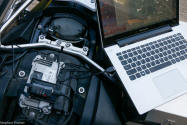 When you run this web based app it will provide the ability with directions on how to update the firmware and configure the camera. It is important to turn 'on' the 'Power on Record' setting via the configuration in order to enable the "dashcam" mode of operation. Although nice for cars for locking critical footage after an accident, you should also turn off the G-sensor to prevent the camera from automatically generating 'locked' files whenever the motorcycle goes over a big bump in the road. Otherwise your microSD card will
eventually fill up after enough off-road rides over rough terrain.
When you run this web based app it will provide the ability with directions on how to update the firmware and configure the camera. It is important to turn 'on' the 'Power on Record' setting via the configuration in order to enable the "dashcam" mode of operation. Although nice for cars for locking critical footage after an accident, you should also turn off the G-sensor to prevent the camera from automatically generating 'locked' files whenever the motorcycle goes over a big bump in the road. Otherwise your microSD card will
eventually fill up after enough off-road rides over rough terrain.
One separate note about selecting the mode of operation with the Innovv
recorder:
To change modes manually from the buttons on the recorder, you must
first press the shutter release button, and after that the mode button
(marked 'M') becomes responsive. But if you just want to operate the
camera in "dashcam" mode as setup with the configuration application,
then you do not need to do anything here, as the camera will
automatically go to video recording mode and start video capture.
When you are done configuring your recorder via the USB connection,
replace the computer to recorder USB cable with the thinner USB power cable wired to the bike.
For my setup I then closed the lid on my home brewed protective case,
and then replaced the seat after making sure the cables have been
properly secured. I did some test rides during the day as well as at night, and after dumping the footage back to my computer I was quite impressed with the quality, resolution, and dynamic range. An alternate way to dump the footage without unplugging the USB cable on the recorder is to simply pop out the microSD card, and then insert that into a reader on your computer.
Given the engine vibration characteristics of the F800GS twin cylinder configuration, I was concerned about the stability of the video footage, especially at higher engine RPMs. But the mounting point on the driving light seems to be sufficiently stable for a reasonably minimal vibration at freeway speed, and perhaps better than if mounted on the handlebars? I also helped cushion the mount by inserting a bit of higher density foam with an adhesive tape on one side (weather stripping for a door jamb works well here) to dampen vibrations from the bike. Reviewing the footage of while riding in traffic, I found it to be very stable with the quality sufficiently clear to read license plate information off cars in front of you.
 You can see some test footage I have posted on YouTube under various road
and traffic conditions here. It is interesting that even in the limited test
ride so far, I captured a red-light runner just as I was about to enter the
intersection after the light turned green for me. The car almost clocks a
few pedestrians as well just as they start stepping off the curb (see the
footage at 2:20).
You can see some test footage I have posted on YouTube under various road
and traffic conditions here. It is interesting that even in the limited test
ride so far, I captured a red-light runner just as I was about to enter the
intersection after the light turned green for me. The car almost clocks a
few pedestrians as well just as they start stepping off the curb (see the
footage at 2:20).
https://www.youtube.com/watch?v=HPFrQBUe9_U
So far I have been happy with the results and performance of this Innovv C3 camera setup on my motorcycle. After about a week of experience so far without issue, I think the next proof point will be after a full season of operation to see how well it holds up.
5/12/2015 update
After a month of use, I have the following additional comments based on my
experience so far:
- The recorder continues to perform well, working as expected in dashcam
mode by overwriting the oldest files with the newest as the storage fills
up. I am getting over 5 hours of footage with a 32GB microSD card.
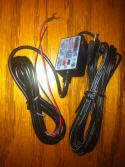 -
Apparently the 'capacitor' version I ordered did not come with a 12V to
micro USB power module, and thus I used one I ordered off of Amazon. But
after ordering a second 'battery' based unit for my DRZ400S dual sport,
it came with the power adapter with pigtails (pictured on the right).
Other readers have also reported recieving this power adapter from
Innovv. This will
allow connection to the 12V supply without having to buy a separate
12V to USB power adapter.
-
Apparently the 'capacitor' version I ordered did not come with a 12V to
micro USB power module, and thus I used one I ordered off of Amazon. But
after ordering a second 'battery' based unit for my DRZ400S dual sport,
it came with the power adapter with pigtails (pictured on the right).
Other readers have also reported recieving this power adapter from
Innovv. This will
allow connection to the 12V supply without having to buy a separate
12V to USB power adapter.
- I tried playing with the shock sensor settings to see how often it
triggers on the 'low' sensitivity setting. But it still ends up creating
locked files about 30% of the time on regular surface streets or the
freeway. Thus I have concluded I just have to keep that feature off.
- There was a period where I was out of town for just over a week
without riding the bike. When reviewing the captured camera footage
after the point I started using the bike again, the date and time
settings on the camera had reset. I believe it is because I have the
'capacitor' version, which relies on the charge in the capacitor in
order to power the time-of-day clock. Apparently one week or more is too
long to keep this running. To reestablish the correct date and time I had to reconnect the
recorder to my notebook computer and rerun the Innovv configuration
application. I suspect the battery version won't have this issue (or not
after a week anyway).
Given there may be periods where you are not riding enough (i.e. during
the winter months) it may not always be practical to keep the
time-of-day is correct if you have the capacitor version. To address
this I would recommend that in the unfortunate case of some incident
recorded with your camera, you may want to do something to manually
record the date and time like holding the clock of your smart phone or
watch in front of the camera before connecting the recorder back to your
computer.
- Stephen Fischer
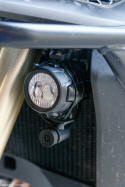
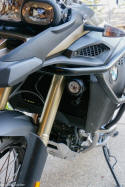
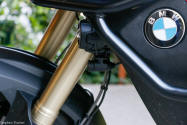
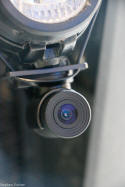
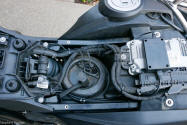
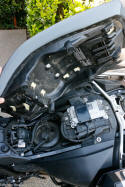
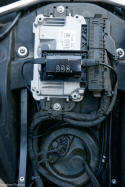
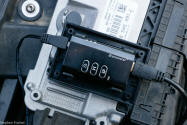
-
Apparently the 'capacitor' version I ordered did not come with a 12V to
micro USB power module, and thus I used one I ordered off of Amazon. But
after ordering a second 'battery' based unit for my DRZ400S dual sport,
it came with the power adapter with pigtails (pictured on the right).
Other readers have also reported recieving this power adapter from
Innovv. This will
allow connection to the 12V supply without having to buy a separate
12V to USB power adapter.




